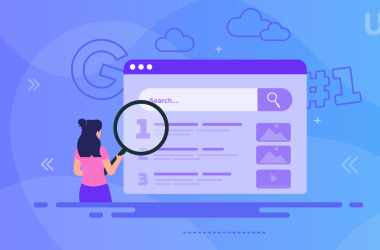There are several ways to check if your website cannibalizes keywords.In this article you also will get to know how to deal with keyword cannibalization.
If you aren’t sure what is keyword cannibalization, read our previous article. You will find out is keyword cannibalization good or bad for your SEO ranking.
How to detect keyword cannibalization on the website?
SEO position monitoring
This method lies in checking whether the SEO monitoring tool shows significant position fluctuations with the change of the ranking page.
For example, the producer ranks for the same phrase on both his website and the store. Both are in the same domain. The producer establishes separate monitoring for both subdomains. What does the SEO monitoring tool show? Large daily position fluctuations.
They result from the fact that Google has strongly linked both subdomains with each other and displays only one result per domain. One day the store occupies the lead, and the other day the producer’s website is at the forefront.
But URL changes are not always a big problem. You ought to verify that the search results do not show two different addresses that barely swap places. It is a very favorable situation for positions in the top 3. But if we occupy the lower regions of the first 10, we should consider consolidating addresses to fight for better places.
Some monitoring systems can count page appearances in the so-called map package. When the home page is not positioned yet, but the company’s business card appears in the SERPs, we can notice significant fluctuations in the charts.
Tip for you: set the home page address with UTM parameters on the Google business card. Thanks to this, you may track what traffic the company’s business card generates.
Google Search Console
To check if the website is not struggling with keyword cannibalization, you can also use Google Search Console. From the side panel, select Performance, then click “New” and select “Query”. Enter the key phrase that interests you. Remember to select the option: “Exact query”. Otherwise, the tool will show you all the keywords that contain the given phrase.
The next step is to go to the page tab below the chart. Ideally, one page URL should appear there. If there are several, you may have a problem with keyword cannibalization.

Because the appearance of the search results is evolving, once in the while there are news and amenities for users. Unfortunately, Google making these changes thinks about users, not creators.
These changes may make it hard to analyze the data provided to you by analytical tools. Having multiple URLs for one phrase is not always a problem. The presence of sitelinks or links in the FAQ schema and the appearance of a Google business card may give a wrong picture of the situation.
Ahrefs
Another tool that successfully detects keyword cannibalization is Ahrefs. After entering the Internet address of the domain and selecting the Organic keywords option from the side menu, we will see a set of keywords for which the domain is displayed. These data can be exported to a file and processed in a separate tool or sorted by the Keyword column and searched for those that are repeated more than once.
It is worth paying attention to the additional markings next to URLs. It may turn out that these addresses appear as sitelinks or the phrase also displays graphics.
Screaming Frog
You can detect a significant part of the problems with keyword cannibalization by using a page crawl tool such as Screaming Frog. To detect potentially problematic addresses, check for duplicate title tags when indexing. These can be pages in pagination, filters, sorting, search results, etc. Especially online stores should pay special attention to this type of page.
Search operator
Google allows you to preview the search results unfiltered by the algorithm. To check if similar subpages do not compete for a given phrase, it is worth entering ”&filter=0” in the browser bar at the very end of the address. It is best to supplement this entry with “&num=100” so you can display the maximum number of results in the SERP on one page.
Then you will be able to see if any of the subpages is lurking in hiding and blocking the right one from being promoted by a few points in the ranking.
Tip for you: This method does not work for queries that display eg Amazon. After turning off filtering, it happens that there are so many results from one domain that it is impossible to find pages that typically rank in the top 20. You can then use an additional search operator and remove the troublesome domain (-example.com)

How to deal with keyword cannibalization?
Keyword cannibalization can be a significant problem in achieving high rankings in SERPs. There are many ways to deal with it. Here are a few of them.
Combining subpages into one
If keyword cannibalization is happening with similar articles, you may want to consider combining them into a single post. The redundant URL should redirect to the correct page (301 redirect).
Rebuilding the structure of a store or blog often has a positive effect on the problem of keyword cannibalization. By creating a well-thought-out website structure, you avoid situations where two pages are optimized for the same phrases. It’s good to remember to redirect the deleted addresses to similar URLs, and not to the home page, as it happens.
Canonical tag
If removing a category or view is not an option, it is worth adding a link tag with the following attributes to the subpage: rel=”canonical” and href=”https://example.com/canonical-address”. In this way, you give a signal to the robots that the valuable content that they should index they can find at a different URL.
Unfortunately, this is not a binding directive and it often happens that robots ignore this instruction in the code.
Noindex tag
Adding a meta tag with the attributes name=”robots” and content=”noindex” in the head section tells crawlers not to index this page. You can also apply blocking at the HTTP response level by adding the X-Robots-Tag header.
Internal linking
The problem of cannibalization is also the result of inconsistent internal linking. Make sure that anchors with similar key phrases point to the same URL. It is a mistake to link using the same anchor – for example “children’s bikes” – to several different pages: categories, blog posts, or tags.

Optimization of the link profile
Links from external domains have great power. If the home page collects links on different anchors, it may turn out that it will cannibalize the store category. While the number of external links in the exact match should be limited, those that exist should direct to a dedicated subpage.
Thoughtful creation of new content
When creating new articles or subpages, it is worth considering whether there will be a cannibalization of keywords with those already present on the site. If you worry about such a situation, update the previously published content in the place of creating something new.
De-optimization
When nothing else works, and we want a given subpage to remain on the website for some reason, it should be de-optimized. It means that you should perform the process opposite to optimization.
You can make it by changing meta tags, removing key phrases from the content, and limiting the number of internal and external links. All these activities should make a subpage stop competing with another for a higher position for a key phrase over time.
What do you think about our article? Feel free to express your opinion in the comments.
Do you think the content we create is professional? No need to be falsely modest, you are right. Everything UltaHost does is professional. So if you want a good SEO ranking, you need to start with professional hosting services. Choose UltaHost hosting platform. Get 24/7 support from our support team. Our powered infrastructure focuses on auto-scaling, performance, and security. Let us make your SEO position better! Check out our plans!










